Hinduism in Southeast Asia
Hinduism in Southeast Asia has a profound impact on the region's cultural development and its history. As the Indic scripts were introduced from India and Nepal, people of Southeast Asia entered the historical period by producing their earliest inscriptions around the 1st to 5th century CE.[1] Today, the only practicing Hindus in Southeast Asia other than Overseas Indians are the Balinese and Tenggerese minorities in Indonesia, and the Cham minority in Cambodia and southern Vietnam.

Hindu civilization also transformed and shaped the social construct and statehood of Southeast Asian regional polity. Through the formation of Indianized kingdoms, small indigenous polities led by petty chieftain were transformed into major kingdoms and empires led by a maharaja with statecraft concept akin to those in India. It gave birth to the former Champa civilisation in southern parts of Central Vietnam, Funan in Cambodia, the Khmer Empire in Indochina, Langkasuka Kingdom and Old Kedah in the Malay Peninsula, the Sriwijayan kingdom on Sumatra, the Medang Kingdom, Singhasari and the Majapahit Empire based in Java, Bali and parts of the Philippine archipelago. The civilisation of India influenced the languages, scripts, written tradition, literatures, calendars, beliefs system and artistic aspects of these peoples and nations.[2]
History
Ancient era
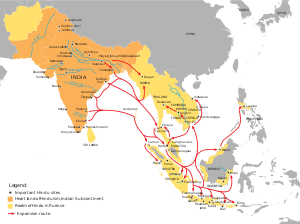
Indian scholars wrote about the Dwipantara or Jawa Dwipa Hindu kingdom in Java and Sumatra around 200 BC. "Yawadvipa" is mentioned in India's earliest epic, the Ramayana. Sugriva, the chief of Rama's army dispatched his men to Yawadvipa, the island of Java, in search of Sita.[3] It was hence referred to by the Sanskrit name "yāvaka dvīpa" (dvīpa = island). Southeast Asia was frequented by traders from eastern India, particularly Kalinga, as well as from the kingdoms of South India .
The Indianised Tarumanagara kingdom was established in West Java around 400s, produced among the earliest inscriptions in Indonesian history. There was a marked Buddhist influence starting about 425 in the region. Around the 6th century, Kalingga Indianized kingdom was established on the northern coast of Central Java. The kingdom name was derived from Kalinga east coast of India.[4] These Southeast Asian seafaring peoples engaged in extensive trade with India and China. Which attracted the attention of the Mongols, Chinese and Japanese, as well as Islamic traders, who reached the Aceh area of Sumatra in the 12th century.
Examples of the Hindu cultural influence found today throughout the Southeast Asia owe much to the legacy of the Chola dynasty. For example, the great temple complex at Prambanan in Indonesia exhibit a number of similarities with the South Indian architecture.[5]
According to the Malay chronicle Sejarah Melayu, the rulers of the Malacca sultanate claimed to be descendants of the kings of the Chola Empire.Chola rule is remembered in Malaysia today as many princes there have names ending with Cholan or Chulan,one such being Raja Chulan, the Raja of Perak.[6]
The Chola school of art also spread to Southeast Asia and influenced the architecture and art of Southeast Asia.[7][8]
Some scholars have pointed out that the legends of Ikshvaku and Sumati may have their origin in the Southeast-Asian myth of the birth of humanity from a bitter gourd. The legend of Sumati, the wife of King Sagar, tells that she produced offspring with the aid of a bitter gourd.[9]
Modern era
Today, vibrant Hindu communities remain in Malaysia, Singapore, Thailand, Medan (Indonesia) and the Philippines mainly due to the presence of Indians, such as Tamil people, who migrated from the Indian subcontinent to Southeast Asia in past centuries. One notably Southeast Asian aspect of Tamil Hinduism is the festival of Thaipusam, while other Hindu religious festivals such as Diwali are also well-observed by Hindus in the region. In Thailand and Cambodia, Thai and Khmer people practised Hindu rituals and traditions along with their Buddhist faith, and Hindu gods such as Brahma are still widely revered .
In Indonesia, it is not only people of Indian descent who practice Hinduism; Hinduism still survives as the major religion in Bali, where native Indonesians, the Balinese people, adheres to Agama Hindu Dharma, a variant of Hinduism derived from ancient Java-Bali Hindu traditions developed in the island for almost two millennia that often incorporates native spiritual elements. Other than the Balinese, a small enclave of Javanese Hindu minorities are also can be found in Java, such as around Tengger mountain ranges near Bromo and Semeru volcanoes, Karanganyar Regency in Central Java, and near Prambanan, Yogyakarta. Similarly, Hinduism is also found among the Cham minority in Southern Vietnam and Cambodia: just like the Javanese, the majority of them are Muslims but a minority are Hindu. In other parts of Indonesia, the term Hindu Dharma is often loosely used as an umbrella category to identify native spiritual beliefs and indigenous religions such as Hindu Kaharingan professed by Dayak of Kalimantan .
.jpg)
The resurgence of Hinduism in Indonesia is occurring in all parts of the country. In the early 1970s, the Toraja people of Sulawesi were the first to be identified under the umbrella of 'Hinduism', followed by the Karo Batak of Sumatra in 1977 and the Ngaju Dayak of Kalimantan in 1980. In an unpublished report in 1999, the National Indonesian Bureau of Statistics admitted that around 100,000 people had officially converted or 'reconverted' from Islam to Hinduism over the previous two decades.[10] The Ministry of Religious Affairs, as of 2007 estimates there to be at least 10 million Hindus in Indonesia.[11]
The growth of Hinduism has been driven also by the famous Javanese prophecies of Sabdapalon and Jayabaya. Many recent converts to Hinduism had been members of the families of Sukarno's PNI, and now support Megawati Sukarnoputri. This return to the 'religion of Majapahit' (Hinduism) is a matter of nationalist pride.
Next to Indonesian Balinese, today, the Balamon Cham are the only surviving native (non-Indic) Hindus in Southeast Asia. In Vietnam there are roughly 160,000 members of the Cham ethnic minority, majority of them adheres Hinduism while some are Muslims.[12] After centuries being dominated by Kinh (Vietnamese), today there are some effort to revive Cham culture.
Cambodia
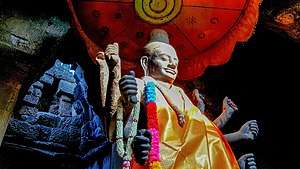
Cambodia was first influenced by Hinduism during the beginning of the Kingdom of Funan. Hinduism was one of the Khmer Empire's official religions. Cambodia is the home of the holy temple of Angkor Wat, the largest Hindu temple in the world. The main religion adhered to in Khmer kingdom was Hinduism, followed by Buddhism in popularity. Initially, the kingdom revered Hinduism as the main state religion. Vishnu and Shiva were the most revered deities, worshipped in Khmer Hindu temples. Temples such as Angkor Wat are actually known as Preah Pisnulok (Vara Vishnuloka in Sanskrit) or the realm of Vishnu, to honour the posthumous King Suryavarman II as Vishnu. Hindu ceremonies and rituals performed by Brahmins (Hindu priests), usually only held among the ruling elites of the king's family, nobles, and the ruling class .
.jpg)
The Khmer Empire has developed a complex society where sophisticated culture, art, and architecture flourish. The Khmer king and his officials were in charge of irrigation management and water distribution, which consisted of an intricate series of hydraulics infrastructure, such as canals, moats, and massive reservoirs called barays. Society was arranged in a hierarchy reflecting the Hindu caste system, where the commoners — rice farmers and fishermen — formed the large majority of the population. The kshatriyas — royalty, nobles, warlords, soldiers, and warriors — formed a governing elite and authorities. Other social classes included brahmins (priests), traders, artisans such as carpenters and stonemasons, potters, metalworkers, goldsmiths, and textile weavers, while on the lowest social level are slaves. The extensive irrigation projects provided rice surpluses that could support a large population. The state religion was Hinduism but influenced by the cult of Devaraja, elevating the Khmer kings as possessing the divine quality of living gods on earth, attributed to the incarnation of Vishnu or Shiva.[13] In politics, this status was viewed as the divine justification of a king's rule. The cult enabled the Khmer kings to embark on massive architectural projects, constructing majestic monuments such as Angkor Wat and Bayon to celebrate the king's divine rule on earth.
The empire's official religions included Hinduism and Mahayana Buddhism until Theravada Buddhism prevailed, even among the lower classes, after its introduction from Sri Lanka in the 13th century.[14] Since then, Hinduism slowly declined in Cambodia, and finally being replaced by Theravadan Buddhist as the major faith in the kingdom. Despite this, Hindu rituals continue to play an important role in the kingdom. Like in neighboring Thailand, the ceremony of coronation is conducted mostly by royal brahmins, during which the sovereign swears in front of the idols of gods Vishnu and Shiva to maintain the ancient national traditions.[15]
Indonesia
Today in Indonesia, Hinduism is practised by 1.7% of the total population. Hindus constitute 83.29% of the population of Bali and 5.75% of the population of Central Kalimantan, as of the 2010 census.[16] However, between the 4th century to 15th century, Hinduism and Buddhism was adhered by the majority of the population, along with native indigenous animism and dynamism beliefs that venerated natural and ancestral spirits. By 15th to 16th-century Islam had supplanted Hinduism and Buddhism as the majority religion in the Indonesian archipelago. The influence of Hinduism has profoundly left its marks on the culture of Bali, Java, and Sumatra. Bali has become the last remnant of once Hindu dominated region.
Hindu influences reached the Indonesian Archipelago as early as first century. In 4th-century, the kingdom of Kutai in East Kalimantan, Tarumanagara in West Java, and Holing (Kalingga) in Central Java, were among the early Hindu states established in the region. The notable ancient Indonesian Hindu kingdoms are Medang i Bhumi Mataram (famous for the construction of the majestic 9th-century Trimurti Prambanan temple) followed by Kediri, Singhasari and the 14th-century Majapahit, the last and largest among Hindu-Buddhist Javanese empires.[17](p19)
The Hindu civilisations have left their marks on Indonesian culture. The epics Mahabharata and Ramayana, became enduring traditions among Indonesian art forms, expressed in wayang shadow puppet and dance performances. Many Indonesian names are Sanskrit-based, and Bahasa Indonesia contains loads of loandwords of Sanskrit origin. The vehicle of Vishnu, Garuda, was adopted as both national emblem Garuda Pancasila and flag carrier national airline named Garuda Indonesia.
Today, the Indonesian government has recognised Hinduism as one of the country's six officially sanctioned religions, along with Islam, Protestantism, Roman Catholicism, Buddhism and Confucianism.[19]
The Hindu communities in Java tend to be concentrated around built temples (pura) or around archaeological temple sites (candi) which are being reclaimed as places of Hindu worship. An important Hindu temple in eastern Java is Pura Mandaragiri Sumeru Agung, located on the slope of Mt. Semeru, Java's highest mountain. Another Hindu temple, built on a site with minor archaeological remnants attributed to the Kingdom of Blambangan, the last Hindu polity on Java, and Pura Loka Moksa Jayabaya (in the village of Menang near Kediri), where the Hindu king and prophet Jayabaya is said to have achieved spiritual liberation (moksa). Another site is the new Pura Pucak Raung in East Java, which is mentioned in Balinese literature as the place from where Maharishi Markandeya took Hinduism to Bali in the 14th century.[20]
An example of resurgence around major archaeological remains of ancient Hindu temple sites was observed in Trowulan near Mojokerto, the capital of the legendary Hindu empire Majapahit. A local Hindu movement is struggling to gain control of a newly excavated temple building which they wish to see restored as a site of active Hindu worship. The temple is to be dedicated to Gajah Mada, the man attributed with transforming the small Hindu kingdom of Majapahit into an empire. Although there has been a more pronounced history of resistance to Islamization in East Java, Hindu communities are also expanding in Central Java near the ancient Hindu monuments of Prambanan. On 9 to 12 November 2019, the grand Abhiṣeka sacred ceremony was performed in this temple compound. This Hindu ritual was held for the first time after 1,163 years after the Prambanan temple was founded on 856.[21][22] The Abhiṣeka ceremony was meant to cleanse, sanctify and purify the temple, thus signify that the temple is not merely an archaeological and tourism site, but also restored to its original function as a focus of Hindu religious activity.[23]
Laos
Hinduism makes up less than 0.1% of the population of Laos. Approximately 7,000 People of Laos are Hindus .
Ancient Laos used to be a part of Hindu Khmer Empire. The Wat Phou is one of the last influences of that period. The Laotian adaptation of the Ramayana is called Phra Lak Phra Lam.
Malaysia
.jpg)
Hinduism is the fourth largest religion in Malaysia. About 2.78 million Malaysian residents (9.3% of the total population) are Hindus, according to 2010 Census of Malaysia.[24]
Most Malaysian Hindus are settled in western parts of Peninsular Malaysia. Indian Hindus and Buddhists began arriving in Malaysia during the ancient and medieval era. A large number of Hindus from South India were brought to Malaysia by British colonial empire during the 19th and 20th century, as indentured labourers to work on coffee and sugarcane plantations and tin mining; later they were deployed in large numbers, along with Chinese Buddhists, on rubber plantations. The British kangani system of recruitment, designed to reduce labour turnover and enhance labour stability, encouraged Hindu workers to recruit friends and family from India to work in British operations in Malaysia. The kangani system brought numerous Tamil Hindus into Malaysia by early 1900s.[25] By 1950s, about 12.8% of Malaysian population professed to be a Hindu.
After Malaysia gained its independence from British colonial empire in 1957, it declared its official state religion as Islam and adopted a discriminatory constitution as well as the Sedition Act of 1971 which limited public debate on Malaysia's treatment of religion, language and citizenship policies.[26][27][28] In recent decades, there have been increasing reports of religious persecution of Hindus, along with other minority religions, by various state governments of Malaysia and its Sharia courts.[26][29] Hindu temples built on private property, and built long before Malaysian independence, have been demolished by Malaysian government officials in recent years.[30] Since the 1970s, there has been large scale emigration of Hindus (along with Buddhists and Christians) from Malaysia.[31][32][33]
Malaysian Hindus celebrate Deepavali (festival of lights), Thaipusam (Lord Murugan festival), Pongal (harvest festival) and Navaratri (Durga festival).
Myanmar
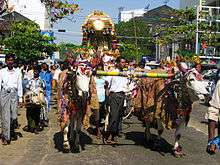
Hinduism in Burma is practised by about 840,000 people, though a reliable census data is not vailable[34] Most Hindus in Myanmar are Burmese Indians. In modern Myanmar, most Hindus are found in the urban centres of Yangon and Mandalay. Ancient Hindu temples are present in other parts of Burma, such as the 11th century Nathlaung Kyaung Temple dedicated to Vishnu in Bagan. Hinduism in Myanmar has also been influenced by Buddhism with many Hindu temples in Myanmar housing statues of the Buddha.[35][36]
Aspects of Hinduism continue in Burma today, even in the majority Buddhist culture. For example, Thagyamin is worshipped whose origins are in the Hindu god Indra. Burmese literature has also been enriched by Hinduism, including the Burmese adaptation of the Ramayana, called Yama Zatdaw. Many Hindu gods are likewise worshipped by many Burmese people, such as Saraswati (known as Thuyathadi in Burmese), the goddess of knowledge, who is often worshipped before examinations; Shiva is called Paramizwa; Vishnu is called Withano, and others. Many of these ideas are part of thirty-seven Nat or deities found in Burmese culture.[37]
The Philippines

Before the arrival of an Arab trader to Sulu Island in 1450 and Ferdinand Magellan, who sailed in behalf of Spain in 1521, the chiefs of many Philippine islands were called Rajas, and the script was derived from Brahmi. Karma, a Hindu concept is understood as part of the traditional view of the universe by many Philippine peoples, and have counterparts such as kalma in the Pampangan language, and Gabâ in Visayan languages. The vocabulary in all Philippine languages reflect Hindu influences.
There are smaller number of followers of Hinduism today at 0.1% of the Philippine population.[38]
Today, there is a "Hindu Temple" (attended mostly by Sindhīs) on Mahatma Gandhi Street and a "Khalsa Diwan Indian Sikh Temple" (attended mostly by Sikhs) on United Nations Avenue. Both are in Manila city's Paco-Pandacan area, the traditional Indian enclave, and are about 15 minutes walk away from each other.[39] As per estimate there are 22 gurudwāras all over the Philippines today, although most of the adherents are Indians, Sri Lankans and Nepalese. There are various Hare Krishna groups in the country that are gaining in popularity.
Singapore
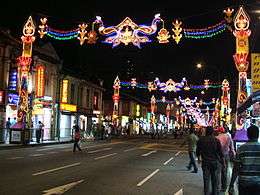
The introduction of Hinduism into Singapore dates back to the early 10th century, during the Chola period. Immigrants from southern India, mostly Tamils, arrived as labourers for the British East India Company, bringing with them their religion and culture. Their arrival saw the building of Dravidian temples throughout the island, and the beginnings of a vibrant Hindu culture. The first temple, Sri Mariamman Temple in Singapore's Chinatown. There are currently about thirty main temples in Singapore, dedicated to various gods and goddesses from the Hindu pantheon. Today, two government bodies deal with all Hindu affairs: The Hindu Endowments Board and The Hindu Advisory Board.
Hindus are a minority in Singapore, comprising about 10.1 percent of its citizens and permanent residents in 2010. Among 15 years or older population, there were about 558,000 Hindus; 37% of all Hindus in Singapore speak Tamil at home, another 42% speak English.[40] Deepavali is a major Hindu festival and a public holiday observed in Singapore.[41]
Thailand
A number of Hindus remain in Thailand. They are mostly located in the cities. In the past, the nation came under the influence of the Khmer Empire, which had strong Hindu roots. Despite the fact that today Thailand is a Buddhist majority nation, many elements of Thai culture and symbolism demonstrates Hindu influences and heritage. For example, the popular epic, Ramakien, is based on the Ramayana.[42] The Royal emblem of Thailand depicted Garuda, the vahana (vehicle) of Vishnu.[43]
The Thai city, Ayutthaya near Bangkok, is named after Ayodhya, the birthplace of Rama. Numerous rituals derived from Brahmanism are preserved in rituals, such as the use of holy strings and pouring of water from conch shells. Furthermore, Hindu deities are worshipped by many Thais alongside Buddhism, such as Brahma at the famous Erawan Shrine, and statues of Ganesh, Indra, and Shiva, as well as numerous symbols relating to Hindu deities are found, e.g., Garuda, a symbol of the monarchy. Reliefs in temple walls, such as the 12th-century Prasat Sikhoraphum near Surin (Thailand), show a dancing Shiva, with smaller images of Parvati, Vishnu, Brahma and Ganesha.[44]
The Devasathan is a Hindu temple established in 1784 by King Rama I. The temple is the centre of Brahminism in Thailand. The royal court Brahmins operate the temple, they perform several royal ceremonies per year.
An annual Giant Swing ceremony known as Triyampavai-Tripavai was held in major cities of Thailand until 1935, when it was abolished for safety reasons.[45] The name of the ceremony was derived from the names of two Tamil language Hindu chants: Thiruvempavai and Thiruppavai. It is known that Tamil verses from Thiruvempavai — poet pratu sivalai ("opening the portals of Shiva's home") — were recited at this ceremony, as well as the coronation ceremony of the Thai king.[46] According to T.P. Meenakshisundaram, the name of the festival indicates that Thiruppavai might have been recited as well.[47] The swinging ceremony depicted a legend about how the god created the world. Outside shops, particularly in towns and rural areas, statues of Nang Kwak as the deity of wealth, fortune and prosperity (version of Lakshmi) are found.[48][49]
The elite, and the royal household, often employ Brahmins to mark funerals and state ceremonies such as the Royal Ploughing Ceremony to ensure a good harvest. The importance of Hinduism cannot be denied, even though much of the rituals has been combined with Buddhism.[50]
According to the Thai Census of 2005, there are 52,631 Hindus living in Thailand, making up just 0.09% of the total population.[51]
Vietnam
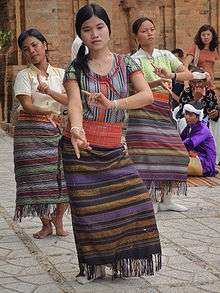
The first recorded religion of the Champa was a form of Shaiva Hinduism, brought by sea from India. Hinduism was a important religion among the Cham people (along with Buddhism, Islam, and indigenous beliefs) until the sixteenth century.[52] Numerous temples dedicated to Shiva were constructed in the central part of what is now Vietnam. The mainly Hindu Óc Eo archeological site in Mekong River Delta in southern Vietnam, dates back to the 7th century and earlier. The Champa civilisation was located in the more southern part of what is today Central Vietnam, and was a highly Indianized Hindu Kingdom, practising a form of Shaivite Hinduism brought by sea from India. Mỹ Sơn, a Hindu temple complex in central Vietnam built by the Cham people is still standing albeit in ruins in Quảng Nam Province, in Vietnam. Since the 15th century under the growing Vietnamese kingdom from the north, Champa was conquered and reduced as a polity. The Chams were subsequently absorbed by the Vietnamese and today are recognised as one of the many ethnic minorities of Vietnam .
The Chams Balamon (Hindu Brahmin Chams) form a majority of the Cham population in Vietnam while most of the remainder are Cham Bani followers of Islam. The term Balamon is considered to have been derived from Brahmin,[53] however, another study suggests that 70% are considered to descend from the Nagavamshi Kshatriya caste[54] (pronounced in Cham(?) as "Satrias"), and claim to be the descendants of the Champa Empire.[55] In any case a sizeable proportion of the Balamon Hindu Cham are considered Brahmins.
Hindu temples are called Bimong in the Cham language and the priests are called Halau Tamunay Ahier.
The exact number of Hindus in Vietnam are not published in Government census, but there are estimated to be at least 50,000 Balamon Hindus, with another 4,000 Hindus living in Ho Chi Minh City; most of whom are of Indian (Tamil) or of mixed Indian-Vietnamese descent. The Mariamman Temple is one of the most notable Tamil Hindu temples in Ho Chi Minh City. Ninh Thuan and Binh Thuan Provinces are where most of the Cham ethnic group (~65%) in Vietnam reside according to the last population census. Cham Balamon (Hindu Cham) in Ninh Thuan numbered 32,000 in 2002 inhabiting 15 of 22 Cham villages.[53] If this population composition is typical for the Cham population of Vietnam as a whole then approximately 40% of Chams in Vietnam are Hindu.
Hinduism is practised by the ethnic Cham people of Vietnam, particularly in the Ninh Thuan province (22%) and Binh Thuan (4.8%).[56]
See also
- Indian religions in Southeast Asia
- Buddhism in Southeast Asia
- Jainism in Southeast Asia
- Indianised kingdom
- Balinese Hinduism
- Spread of Indian influence
- Trading routes
- Indus-Mesopotamia relations
- Maritime history of India
- Indian Ocean trade
- Silk route
- Ancient maritime history
Further reading
- Cœdès, George (1968). Walter F. Vella (ed.). The Indianized States of Southeast Asia. trans.Susan Brown Cowing. University of Hawaii Press. ISBN 978-0-8248-0368-1.CS1 maint: ref=harv (link)
- Lokesh, Chandra, & International Academy of Indian Culture. (2000). Society and culture of Southeast Asia: Continuities and changes. New Delhi: International Academy of Indian Culture and Aditya Prakashan.
- R. C. Majumdar, Study of Sanskrit in South-East Asia
- R. C. Majumdar, India and South-East Asia, I.S.P.Q.S. History and Archaeology Series Vol. 6, 1979, ISBN 81-7018-046-5.
- R. C. Majumdar, Champa, Ancient Indian Colonies in the Far East, Vol.I, Lahore, 1927. ISBN 0-8364-2802-1
- R. C. Majumdar, Suvarnadvipa, Ancient Indian Colonies in the Far East, Vol.II, Calcutta,
- R. C. Majumdar, Kambuja Desa Or An Ancient Hindu Colony In Cambodia, Madras, 1944
- R. C. Majumdar, Hindu Colonies in the Far East, Calcutta, 1944, ISBN 99910-0-001-1 Ancient Indian colonisation in South-East Asia.
- R. C. Majumdar, History of the Hindu Colonization and Hindu Culture in South-East Asia
- Daigorō Chihara (1996). Hindu-Buddhist Architecture in Southeast Asia. BRILL. ISBN 90-04-10512-3.
- Hoadley, M. C. (1991). Sanskritic continuity in Southeast Asia: The ṣaḍātatāyī and aṣṭacora in Javanese law. Delhi: Aditya Prakashan.
- Hughes-Freeland, F. (1991). Javanese visual performance and the Indian mystique. Delhi: Aditya Prakashan.
- The journey of the Goddess Durga: India, Java and Bali by Ariati, Ni Wayan Pasek, 2016, ISBN 9788177421521, Aditya Prakashan, New Delhi
References
- Guy, John (2014). Lost Kingdoms: Hindu-Buddhist Sculpture of Early Southeast Asia, Metropolitan museum, New York: exhibition catalogues. Metropolitan Museum of Art. ISBN 9781588395245.
- "The spread of Hinduism in Southeast Asia and the Pacific". Britannica.
- History of Ancient India Kapur, Kamlesh
- Coedès, George (1968). Walter F. Vella (ed.). The Indianized States of Southeast Asia. trans.Susan Brown Cowing. Uny of Hawaii Press. ISBN 978-0-8248-0368-1.
- Kulke, Hermann (2004). A history of India. Rothermund, Dietmar, 1933- (4th ed.). New York: Routledge. ISBN 0203391268. OCLC 57054139.
- Aklujkar, Ashok; Kalyanaraman, A. (1971). "Aryatarangini: The Saga of the Indo-Aryans". Pacific Affairs. 44 (3): 451. doi:10.2307/2755739. ISSN 0030-851X. JSTOR 2755739.
- Promsak Jermsawatdi (1979). Thai art with Indian influences. Abhinav Publications. OCLC 6237916.
- Bowman, John (31 January 2000). Columbia Chronologies of Asian History and Culture. New York Chichester, West Sussex: Columbia University Press. doi:10.7312/bowm11004. ISBN 9780231500043.
- Elst, Koenraad (1999). Update on the Aryan Invasion Debate. Aditya Prakashan. ISBN 81-86471-77-4.; Sergent, Bernard: Genèse de l'Inde, 1997.
- "Archived copy". Archived from the original on 20 August 2004. Retrieved 24 July 2004.CS1 maint: archived copy as title (link)
- United States Department of State
- Adam Bray (18 June 2014). "The Cham: Descendants of Ancient Rulers of South China Sea Watch Maritime Dispute From Sidelines, The ancestors of Vietnam's Cham people built one of the great empires of Southeast Asia". National Geographic.
- Sengupta, Arputha Rani (Ed.) (2005). God and King : The Devaraja Cult in South Asian Art & Architecture. ISBN 8189233262. Retrieved 14 September 2012.CS1 maint: extra text: authors list (link)
- Keyes, 1995, pp.78–82
- https://www.phnompenhpost.com/national/royal-cambodian-coronation
- "Sensus Penduduk 2010".
- Ricklefs, Merle Calvin (1993). A history of modern Indonesia since c. 1300 (2nd ed.). Stanford University Press / Macmillans. ISBN 9780804721950.
- Beryl De Zoete, Dance and Drama in Bali, ISBN 978-9625938806
- Hosen, N (8 September 2005). "Religion and the Indonesian Constitution: A Recent Debate" (PDF). Journal of Southeast Asian Studies. Cambridge University Press. 36 (3): 419–440. doi:10.1017/S0022463405000238. Archived from the original (PDF) on 28 August 2006. Retrieved 26 October 2006.
- "Kisah Kedatangan Rsi Markandeya Versi Bali Majapahit dan Bali Aga - Beritabali.com". aboutbali.beritabali.com (in Indonesian). Retrieved 19 April 2020.
- "Umat Hindu DIY Gelar Ritual Pensucian Candi Prambanan Pertama Setelah Ribuan Tahun » Badan Dharma Dana Nasional". Badan Dharma Dana Nasional (in Indonesian). 13 November 2019. Retrieved 19 April 2020.
- "Upacara Abhiseka di Candi Prambanan Yogyakarta by | The Jakarta Post Images". thejakartapostimages.com. Retrieved 4 December 2019.
- Kurnia, Fadjrin (5 November 2019). "Abhiseka Prambanan". http://bumn.go.id/ (in Indonesian). Retrieved 4 December 2019. External link in
|website=(help) - 2010 Population and Housing Census of Malaysia (Census 2010) Department of Statistics Malaysia, Official Portal (2012)
- Sandhu (2010), Indians in Malaya: Some Aspects of Their Immigration and Settlement (1786-1957), Cambridge University Press, ISBN 978-0521148139, pp. 89-102
- 2011 Report on International Religious Freedom - Malaysia U.S. State Department (2012)
- Gill & Gopal, Understanding Indian Religious Practice in Malaysia, J Soc Sci, 25(1-2-3): 135-146 (2010)
- Raymond Lee, Patterns of Religious Tension in Malaysia, Asian Survey, Vol. 28, No. 4 (Apr. 1988), pp. 400-418
- Religious Freedom Report 2013 - Malaysia U.S. State Department (2014)
- Religious Freedom Report 2012 - Malaysia U.S. State Department (2013)
- Malaysian Indian Community: Victim of ‘Bumiputera’ Policy Archived 13 September 2014 at the Wayback Machine ORF Issue Report (2008)
- Amarjit Kaur, Indian migrant workers in Malaysia – part 1 Australian National University
- Amarjit Kaur, Indian migrant workers in Malaysia – part 2 Australian National University
- Table: Religious Composition by Country, in Numbers Pew Research Center (December 2012)
- https://www.bbc.com/news/world-asia-25438275
- https://frontiermyanmar.net/en/myanmars-hindu-community-looks-west
- Thant Myint-U (2001), The Making of Modern Burma, Cambridge University Press, ISBN 978-0521799140, pp. 27-47
- http://www.globalreligiousfutures.org/countries/philippines/religious_demography#/?affiliations_religion_id=0&affiliations_year=2010
- In the late 1970s and early 1980s, the ISKCON temple was right beside the Hindu Temple.
- Census of population 2010 Archived 13 November 2013 at the Wayback Machine Singapore Department of Statistics (2011)
- Public Holidays Ministry of Manpower, Singapore
- "Ramakien". Royal Thai Embassy.
- "The concept of Garuda in Thai society".
- Sikhoraphum, Thailand, Arts & Archaeology Journal
- M. E. Manickavasagom Pillai (1986). Dravidian Influence in Thai Culture. Tamil University. p. 69.
- Upendra Thakur (1986). Some Aspects of Asian History and Culture. Abhinav. pp. 27–28. ISBN 978-81-7017-207-9.
- Norman Cutler (1979). Consider Our Vow: Translation of Tiruppāvai and Tiruvempāvai Into English. Muttu Patippakam. p. 13.
- Ara Wilson (2008), The Sacred Geography of Bangkok’s Markets, International Journal of Urban and Regional Research, Volume 32.3, September 2008, page 635
- Jonathan Lee, Fumitaka Matsuoka, Edmond Yee and Ronald Nakasone (2015), Asian American Religious Cultures, ABC, ISBN 978-1598843309, page 892
- "Hinduism Today | Thailand | July/August/September, 2003". Archived from the original on 30 October 2006. Retrieved 3 September 2006.
- http://popcensus.nso.go.th/show_table.php?t=t5&yr=2543&a=1
- Phuong, Tran Ky; Lockhart, Bruce (2011). The Cham of Vietnam: History, Society and Art. NUS Press. pp. 4–6. ISBN 978-9971-69-459-3.
- Champa and the archaeology of Mỹ Sơn (Vietnam) By Andrew Hardy, Mauro Cucarzi, Patrizia Zolese p.105
- India's interaction with Southeast Asia, Volume 1, Part 3 By Govind Chandra Pande, Project of History of Indian Science, Philosophy, and Culture, Centre for Studies in Civilizations (Delhi, India) p.231,252
- International Religious Freedom Report 2004, U.S. Department of State.
- http://www.gso.gov.vn/Modules/Doc_Download.aspx?DocID=12724
External links
- Hinduism in Southeast Asia
- Map of Khmer Empire art reveals ancient urban sprawl
- Thailand Hinduism - A report on Hinduism in Thailand
- Overview of Hindu influence in Thailand
- Hindu-Buddhist Java and Southeast Asia
- Hindu-Kaharingan Tiwah ceremony in Borneo
- Hindu revival in Java
- A tribute to hinduism
- Hindu influence in Southeast Asia
- Siddha Yoga Tradition in Malaysia
- Heritage bid unites border rivals

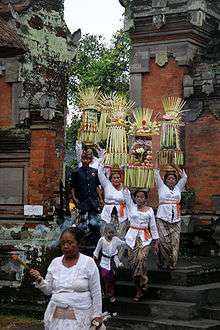
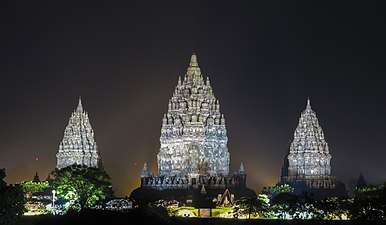
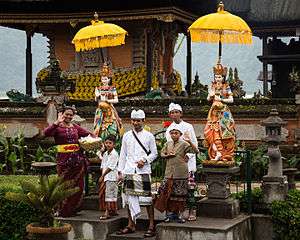
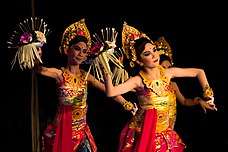
_(6042345760).jpg)